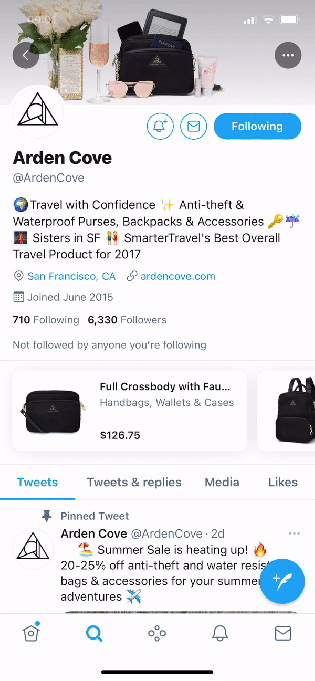Twitter this morning will launch a pilot in the U.S. aimed at testing the potential for e-commerce on its platform. The company is introducing a new “Shop Module” that offers brands, businesses and other retailers the ability to showcase their products to Twitter users directly on their profile. Users will then be able to scroll through a carousel of product images, and tap through on a product they’re interested in purchasing. This opens up the business’s website inside the Twitter app itself, where the customer can learn more about the product in question and make a purchase.
The Shop Module itself will appear in a new, dedicated space at the top of a supported Twitter profile, which can be seen by U.S. users in English on iOS devices.
The company tells us that only businesses with a Professional Profile will be able to use the feature at this time.
Professional Profiles, which began testing in April, give businesses, non-profits, publishers and creators the ability to display specific information about their business directly on their profile, including things like their address, phone number, operating hours, and more. Essentially, it’s the Twitter equivalent to something like a Facebook Page for a business.
At launch, the Shop Module will be made available to only a small group of pilot testers. In addition to gaming retailer @GameStop and travel brand @ArdenCove, Twitter says there will only be approximately 10 other brands across the lifestyle, traditional retail, gaming, media and entertainment, tech and telco industries who will gain access to the new feature.
At present, Twitter isn’t offering a way for interested businesses to sign up for the pilot, as the company is only in the initial phases of testing this feature.

Image Credits: Twitter
While Twitter users often discuss products on the app and even reach out to companies directly for help with purchases, it’s unclear whether or not users will come to view Twitter as a shopping platform.
With the pilot, Twitter says it wants to better understand what sort of products drive traffic to online retailers. For example, it wants to determine whether people are inspired by online conversations in the heat of the moment — like sports fans buying team apparel — or whether Twitter users could be encouraged to make purchases of a more lasting impact, like products for a new skincare routine. Having a diverse lineup of early pilot testers will help it to compare data across verticals to learn what works best.
Twitter says it will also work directly with businesses to better understand their needs through the creation of a new Merchant Advisory Board, which will consist of “best-in-class examples” of merchants on Twitter.
The company earlier this year had mentioned its plans to expand into e-commerce.
At Twitter’s Analyst Day presentation in February, where it first announced its Super Follow platform for creators, the company also briefly mentioned it planned to invest in e-commerce.
“We’re…starting to explore ways to better support commerce on Twitter,” Twitter Revenue Lead, Bruce Falck, had said during the event. “We know people come to Twitter to interact with brands and discuss their favorite products. In fact, you may have even noticed some businesses already developing creative ways to enable sales on our platform,” he continued.
“This demand gives us confidence in the power of combining real-time conversation with an engaged and intentional audience. Imagine easily discovering, and quickly purchasing, a new skincare product or trendy sneaker from a brand you follow with only a few clicks,” Falck added.
Since then, Twitter has tested a new e-commerce feature for tweets, which allowed businesses to link out to online product pages — like those on a Shopify store, for instance.
Twitter CFO Ned Segal also touted the potential to shop on Twitter when speaking to investors at the J.P. Morgan Technology, Media and Communications conference in May, noting that people “do a lot of research on Twitter before they buy something.”
Twitter’s entry into online shopping comes at a time when social platforms are ramping up their investments in e-commerce. Facebook has made major moves into e-commerce with shopping features across Facebook, Instagram and WhatsApp, including with online storefronts, integrated checkout, product drops, video shopping, and more.
Shopify has also partnered with a number of tech platforms, including Facebook, TikTok and Google, to make it easier for consumers to connect with products sold by its merchants.
Twitter had before attempted to run a commerce operation and failed. In 2017, the company begin to wind down its “Buy” button product, which had allowed Twitter users click to make purchases, and the retailer partnerships associated with that effort due to lack of traction. Clearly, the company believes the time is now right to try again.

Recent Comments